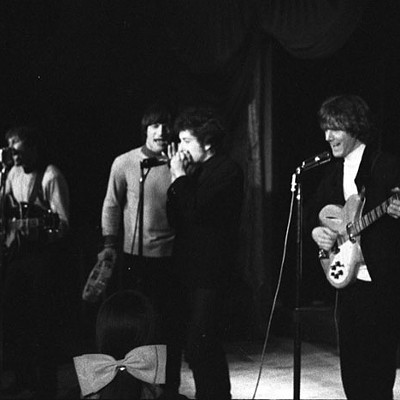Support Us
Houston's independent source of
local news and culture
account
- Welcome,
Insider - Login
- My Account
- My Newsletters
- Contribute
- Contact Us
- Sign out
The Road to Early Rock & Roll Stardom Ran Straight Through Houston
William Michael Smith June 10, 2015 6:00AM
[
{
"name": "Related Stories / Support Us Combo",
"component": "11591218",
"insertPoint": "4",
"requiredCountToDisplay": "4"
},{
"name": "Air - Billboard - Inline Content",
"component": "11591214",
"insertPoint": "2/3",
"requiredCountToDisplay": "7"
},{
"name": "R1 - Beta - Mobile Only",
"component": "12287027",
"insertPoint": "8",
"requiredCountToDisplay": "8"
},{
"name": "Air - MediumRectangle - Inline Content - Mobile Display Size 2",
"component": "11591215",
"insertPoint": "12",
"requiredCountToDisplay": "12"
},{
"name": "Air - MediumRectangle - Inline Content - Mobile Display Size 2",
"component": "11591215",
"insertPoint": "4th",
"startingPoint": "16",
"requiredCountToDisplay": "12"
}
,{
"name": "RevContent - In Article",
"component": "12527128",
"insertPoint": "3/5",
"requiredCountToDisplay": "5"
}
]
In a nice coincidence, the past few weeks saw the release of two items with huge significance in the world of early rock and roll. Not only has Concord Music Group/Specialty Records just released a three-disc set that includes the earliest and most historically significant Little Richard sides, Directly From My Heart: The Best of the Specialty and Vee-Jay Years, Houston resident and early Little Richard band member Grady Gaines has just published his biography, I’ve Been Out There: On the Road with the Legends of Rock ‘n’ Roll.
Gaines’s volume, co-written with Rod Evans, tells the nitty-gritty back story of being on the road 24/7/365 with a hard-traveling and even harder-partying band in the days of segregation. The liquor and drugs flow freely — although Gaines insists drugs were never his thing — and the sex is staggering, just for the amount and casualness of it all. Gaines also offers a nice peek into the days of Club Matinee, Don Robey, and the Fifth Ward black community of that era. The book is not without some laughs and some tender feelings, but for the most part it’s as free-wheeling as the lifestyle Gaines and the Upsetters lived for several decades.
The Little Richard box set is a must for anyone interested in some of the earliest, most important recordings in the history of rock and roll. From a Houston history standpoint, the ironic thing is that Richard Penniman had been living at least part time in Houston a couple of years just prior to his explosion onto the national and world scenes with the issuance of “Tutti Frutti,” the shot heard round the world. Penniman would have 14 songs in the R&B charts in the next 18 months on the Specialty label and would become a millionaire living in the choicest neighborhood in Los Angeles.
Penniman had cut some sides for RCA that went nowhere in 1951 before signing to Don Robey’s local label, Duke-Peacock, where he cut some blues sides that again went nowhere. Penniman and Gaines were playing together as early as 1953, when Penniman’s band the Tempo Toppers would pair with the Deuces of Rhythm, a local husband/wife-led band at Club Matinee. Gaines was part of one of several Duke-Peacock session teams under the direction of maestro Joe Scott.
Penniman sent a demo record to Specialty Records president Art Rupe in Los Angeles in February, 1955, after cutting several sides for Robey that went nowhere. Rupe loaned Penniman money to buy out his contract with Robey (I’d love to have seen and heard that transaction go down). Once free of Robey, Penniman went to New Orleans on Rupe’s instructions to record with Fats Domino's session band, the “A team,” and producer Bumps Blackwell at Cosimo Matassa’s J&M studio. It may not have been the first rock and roll record, but it took the newborn genre to an excitement and chart level no other record of its kind had yet achieved.
As detailed in Gaines’s book, shortly after the record exploded on radio, Penniman sent for Gaines and fellow Houston sax man Clifford Burks to join the Upsetters at a gig in New Jersey. With his formal training, Gaines quickly became the bandleader and would stay with Little Richard until he suddenly gave up rock and roll in late 1957 to enter the seminary and become a minister.
Already known as the hottest band in rock and roll, Gaines and the Upsetters were immediately in demand, going out with Little Willie John before becoming Sam Cooke’s full-time band. Gaines stayed with Cook until his death in 1964, and would go on to tour or record with an unthinkable list of rock and roll, soul, R&B, and even pop artists, all of which is chronicled in his biography.
As for the box set, it comes with a 36-page booklet with rare photos from across Little Richard’s early career as well as a brief history of his life in excellent liner notes by music historian Billy Vera. The two discs of Specialty material contain all of the original charting hits as well as some obscure stunners. The third disc details Richard’s years at the vaunted Vee-Jay label. According to Vera, Vee-Jay had just lost the Beatles and the Four Seasons and, in a move that would hopefully be mutually beneficial, Vee-Jay management sought to revive Little Richard’s career in the wake of James Brown’s ascendancy to the top of the R&B market, in the hopes of reviving the rapidly sinking label. But while it did bring Little Richard back into the public eye for a bit, both Richard’s career and Vee-Jay were on the rocks. It was not until Little Richard began to dress in his extremely gaudy fashion with all the makeup and wild hair that he revived his career via late-night talk shows in the '70s.
For his part, Gaines soldiers on, working the high-dollar party circuit and occasionally playing out for the general public at the Big Easy.
KEEP THE HOUSTON PRESS FREE...
Since we started the Houston Press, it has been defined as the free, independent voice of Houston, and we'd like to keep it that way. With local media under siege, it's more important than ever for us to rally support behind funding our local journalism. You can help by participating in our "I Support" program, allowing us to keep offering readers access to our incisive coverage of local news, food and culture with no paywalls.
William Michael Smith
Trending Music
- How Much Longer Can Classic Rock Rule the Roost?
- Wang Chung Headline a Musical Time Trip to the '80s...and Land on the Moon!
- Top 10 Butt-Rock Bands of All Time
-
Sponsored Content From: [%sponsoredBy%]
[%title%]

Don't Miss Out
SIGN UP for the latest
Music
news, free stuff and more!
Become a member to support the independent voice of Houston
and help keep the future of the Houston Press FREE
Use of this website constitutes acceptance of our
terms of use,
our cookies policy, and our
privacy policy
The Houston Press may earn a portion of sales from products & services purchased through links on our site from our
affiliate partners.
©2024
Houston Press, LP. All rights reserved.




